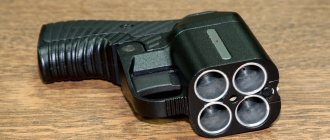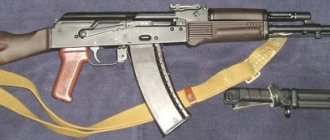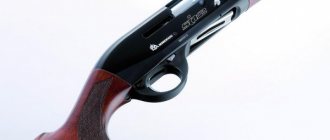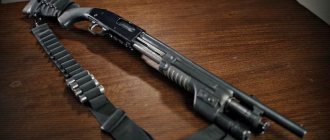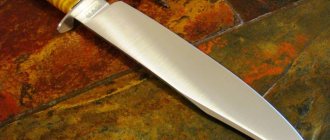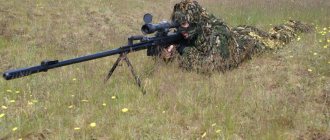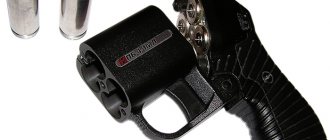The right to self-defense is one of the key human rights. Everyone can and should protect themselves from illegal actions by third parties: this is true for a guy, a girl, a motorist, a schoolchild, and anyone else.
But, as you already know from the first lesson, the range of issues relating to taking necessary defense measures is very problematic from a legal position. And the most important aspect here is the right to use means of self-defense, as well as their legality. We will examine these problems in the third lesson.
What should a self-defense weapon be?
You can defend yourself using a variety of objects, devices and products.
A bright flashlight and an ax can be a means of stopping the enemy. Even an ordinary strong and weighty stick in skillful hands will help fight off both an inadequate person and an angry dog. However, all this applies to objects that accidentally came to hand. As for weapons intended for self-defense, they should always be at hand. Rule 1. Weapons for self-defense must be carried constantly, that is, convenient and uncluttered.
That is why large objects, for example, baseball bats, are poorly suited for self-defense - carrying them with you is difficult and inconvenient (perhaps, except for use by motorists), concealed carrying is excluded. If the attacker sees the bat, he will carry out an attack taking this fact into account, and then the result can be disastrous. This leads to the second feature of a good weapon for self-defense.
Self-defense products should be small and fit in your pocket
Rule 2. Possibility of concealed wearing of means of protection against attack.
Russia has a special attitude towards weapons and self-defense. Even when protecting life and health, and even more so property, there is a great risk of exceeding the measures of necessary self-defense - in this case, you can get a very real sentence and face a criminal case. Both the judiciary and the executive branch tend to interpret such incidents not in favor of the defender.
Rule 3. Self-defense weapons must be non-lethal.
This means that it can be used to harm a person: immobilize, hurt, even injure, but in no case kill. Considering that even everyday objects, such as a table knife or an ax, can cause injuries incompatible with life if handled carelessly, even non-lethal weapons must be handled with care.
Finally, it is worth taking into account that a significant number of weapons in Russia are not allowed to be purchased, carried or used without special permits, the list of which can be very long. For example, to legally own a long-barreled non-rifled weapon (shotgun), you must have not only a license, but also a hunting license. Rifled hunting weapons require at least 5 years of hunting “experience,” and short-barreled weapons (that is, most suitable for self-defense functions) are generally prohibited for circulation by civilians.
How to get a weapons permit for self-defense
Rule 4. The means of defense should preferably not require a license or other permits to own and carry.
This narrows the list of legal self-defense weapons that anyone can purchase, carry, and use.
Why martial arts are not effective for self-defense on the street
You've probably already read similar articles: “10 best martial arts”, “TOP 10 martial arts for self-defense”, “10 most powerful and dangerous martial arts” and so on. Almost always, such articles and videos talk about the advantages of martial arts for self-defense on the street and personal safety in everyday life.
I want to immediately refute this myth.
No combat sport can prepare you for a street fight or a real attack. For several reasons:
1. There are no prohibited equipment or rules on the street. No matter how popular a style or sport is, it is first and foremost a sport or even gymnastics. With its own rules. system of preparation for sports competitions. With prohibited equipment and safety precautions.
2. In the competitive practice of most types of martial arts, one-on-one fights with an opponent are used. On the street there is a high probability of running into a group of opponents. Some of which can hide in the crowd and attack from behind.
3. Most street fights use powerful psychological pressure, for which athletes are most often not prepared. Berserker behavior. For such behavior in the ring or on the mat, fighters who apply pressure are punished.
4. The unexpectedness and transience of the fight. The level of preparedness and weight category of opponents are most often very different. On the tatami they always try to avoid such differences in levels.
5. Using improvised objects. This is practically not taught in any martial arts school. And since they don’t teach you to attack. This means they don’t teach how to defend themselves.
That is why a street fight is contraindicated for a good fighter - an athlete. This is why so many self-confident Champions die on the street, or are injured for life.
This is not an unfounded statement. You can read the story of Ivan Kirp on Wikipedia. I know him.
His fighting career ended in a street fight. And there are many such stories. Wrestler Yuri Vlasko was killed on Lake Baikal with a knife in the neck. Murder of Dmitry Krivosheev near the IL Tokyo cafe in the center of Voronezh.
Athletes do not always win street fights. I already wrote about the statistics of knockouts in street fights in this article: “How to deliver a knockout blow - 3 components”
I’ll write a brief conclusion here: physical STRENGTH and TIMING decide more than technique. The striking technique is important in sports competitions, and is not so significant for self-defense and in a real fight.
What do they study in special forces?
Very often, coaches and adherents of sports disciplines say. that some type of martial arts is used for training in special forces.
For example, I see and hear information that Korean police practice taekwondo, and kyokushinkai is used in special forces around the world. But this is just self-promotion of styles.
Not that it's not true. Every more or less famous martial arts coach trained someone from the special forces. And sometimes organized groups. For example, I have in my bins the training of the Rosinkas team and the VSM Shield GBR, and a lot of thanks from the guys who fought in hot spots.
GBR VSM Shield with Grigory Vladimirovich Chuiko
But let's take a common sense look at who really needs martial arts techniques?
Obviously not military.
In war, the chances of a fist fight are almost zero. How much of a moron do you have to be to meet an enemy soldier, and neither of them would have a small arms, knife or sapper shovel?
Therefore, the military needs courses and trainers in shooting and weapon handling. And only hand-to-hand combat is used as general physical training. Such a martial art really exists and is even available to civilians. This is Krav Maga.
Everything else is off the shelf.
But will Israeli units share their equipment with other states? I don't think so. And those instructors who train civilians do not necessarily know enough to fully train special forces.
All trainers who position themselves as special forces trainers and teach civilians are potentially dangerous for their country. Except for Israel or another country where there is a continuous war.
This is why there are so many freaks in this topic around the world. They bring benefits to the state. Creating competition for truly knowledgeable specialists. More often than not, freaks know better how to captivate people with their system than real war specialists.
Rapid response teams
If we are talking about private offices, private security companies or even the police, then they really need the technique of fighting without weapons. Well, and possession of special means available: gas or traumatic weapons, rubber batons, tonfa.
And since knives and sharpening are often used in everyday life. blades. awl. hammers, rosettes, flutes, etc. I think they would benefit greatly from lessons in knife fighting and stick fighting.
The use of service firearms threatens a lengthy debriefing and may result in prison. That’s why shooting here is general physical training. GBR and police officers should really practice martial arts.
Vladimir Moskalenko, knife fight
I would suggest that these structures learn knife fighting, stick fighting, and submissions, especially standing submissions.
And here. Oddly enough, I see a huge empty niche. There is no martial art that can fill the niche of painful techniques in the standing position. More likely. because the checks are small and employers do not spend money on cannon fodder - their employees.
Japanese Jiu Jitsu could perhaps close this gap. But there will never be Japanese jiu jitsu in Russia. For the same reason that there will be no combat Krav Maga.
Some people think that combat sambo and BJJ rule. But combat sambo and especially Brazilian jiu jitsu are not suitable for the purposes of the GBR. Why? Read this article about combat sambo and draw your own conclusions: “What is combat sambo. combat section of the fight >>»
As for BJJ, although it is a great gymnastics for the body and mind, it is a combat sport, not a martial art. I wrote a little about the classification of styles here: “Martial art. how to choose - expert advice >>»
Why is it so important to train martial arts skills?
Yet martial arts training can save your life. Even if it's a combat sport. The most important thing is the right approach to training.
And if you are lucky with a coach, then you don’t have to think too much. The coach instills the skill of acting in an extreme situation. This is why it is so important to find a competent trainer. And be sure to explain to him that you need self-defense, not sport.
I already wrote how to find the right coach here: “How to find a coach>>” and in my book: “A step-by-step guide for learning mixed martial arts without a coach>>”
This is most likely expensive, since it is not included in the standard sports program. Expensive for you. But is your life worth less? You always have to pay for your actions and decisions. And not always with money. Sometimes health and even life.
Voting for the best weapon for self-defense
What self-defense weapon would you choose or recommend?
"OSA" PB 4-2
12.12 % ( 4 )
MP 79 9
15.15 % ( 5 )
Fort - 12T
12.12 % ( 4 )
ZEUS-M DK.111
0.00 % ( 0 )
THUNDER CD. 111
9.09 % ( 3 )
PHANTOM DK.111
6.06 % ( 2 )
TASER 2019
0.00 % ( 0 )
Wasp 1101 "Police"
3.03 % ( 1 )
PFEFFER KO JET
21.21 % ( 7 )
Fighter
0.00 % ( 0 )
Sword
6.06 % ( 2 )
Fakel-2
6.06 % ( 2 )
Hot pepper
0.00 % ( 0 )
Smith & Wesson M&P Tactical Pen-2
6.06 % ( 2 )
Boker Multipurpose Pen
0.00 % ( 0 )
Aerosol guns
The most prominent representative of aerosol pistols designed for self-defense is the Dobrynya pistol.
Externally, the weapon resembles a small-sized combat pistol and is equipped with special cartridge cartridges (BAM) filled with a damaging mixture.
Loading occurs from above into a magazine built into the handle of the device and holding 5 aerosol cartridges.
When you press the trigger, irritants are released through the barrel, after which the discharged BAM is removed automatically. Moreover, to throw a damaging aerosol, you can use not only standard ammunition, but also BAMs of reduced power.
You may be interested in an article about the Premier gas pistol for self-defense.
The Dobrynya aerosol pistol has modest dimensions: Its weight is 175 grams, its length and height are 140 by 120 millimeters, its width is 28 millimeters, which allows this device to be carried secretly and used suddenly. Advantages:
- Compactness.
- Ease of use.
- Efficiency.
Flaws:
- Do not use in tight spaces or in headwinds.
Self-defense equipment that you can carry without a license
Any citizen in a democratic state has the right to self-defense, including with the use of special means. Article 3 “Civilian Weapons” of Law 150-FZ “On Weapons” allows you to purchase even firearms, for example, for hunting and sport.
However, it cannot be carried with you at all times and a permit is required to purchase it. But there are self-defense means that, according to Article 13 of Law No. 150-FZ, citizens of the Russian Federation who have reached the age of 18 years can purchase without obtaining a license.
Pneumatics
Unlicensed pneumatic weapons cannot have a power greater than 7.5 J and a caliber greater than 4.5 mm . That's why some compare it to a children's toy. A bullet can only leave a small abrasion if accurately hit from a few meters into exposed skin. Even if you have light clothing and shoot at point-blank range, the aggressor will not feel anything.
The shot is fired using the energy of compressed air previously pumped into the tank and other technologies.
So the calculation is mainly on the psychological impact. In addition, air guns are very similar to real firearms, so the attacker may well retreat.
Despite the above restrictions, all pneumatic weapons are made of metal and, in the event of a threat to life, can be used in hand-to-hand combat to enhance the blow.
7.5 J air guns have the same limitations as the real thing. You can get a hefty fine for firing it in the wrong place.
What is joint liability for utility debts?
Read
Passing a car inspection: for whom the procedure is mandatory and changes you should know about
Read
Stun gun
Refers to non-lethal types of weapons, divided into contact (ESH) and remote (DESHU) types.
In Russia, you can only use a certified domestic device with a power of no more than 3 watts.
Law enforcement officers can use stun guns with a power of up to 10 watts; special permission is required for this.
A stun gun is used to protect against animals and aggressive people. The principle of this means of self-defense is based on the direct action of an electric discharge on the attacker. To activate the device, the electrodes of the contact devices must be pressed forcefully against the opponent’s skin and held for 1-3 seconds.
Each of the models has its own advantages and disadvantages.
Contact shockers are compact in size and can produce several discharges during a confrontation.
A significant disadvantage is that to use it you will have to come into close contact with the attacker.
Remote devices allow you to influence an attacker from a distance of 1 to 4 meters, in addition, they are more powerful than contact devices. However, it will not be possible to issue a shock more than once.
Mikhail Suvorov
Leading lawyer of the Legal.Center portal. Experience – 26 years
Ask a Question
For self-defense, a citizen has the right to use domestically produced electroshock devices that have output parameters that comply with the requirements of Russian legislation (Law No. 248-FZ of July 19, 2011).
